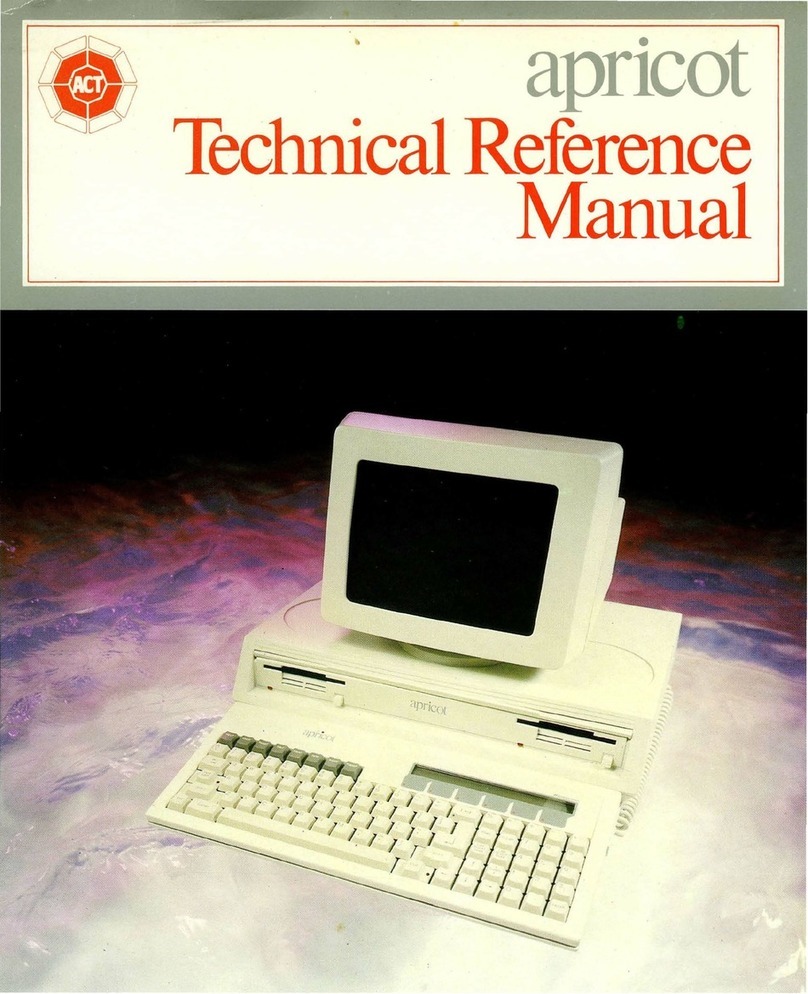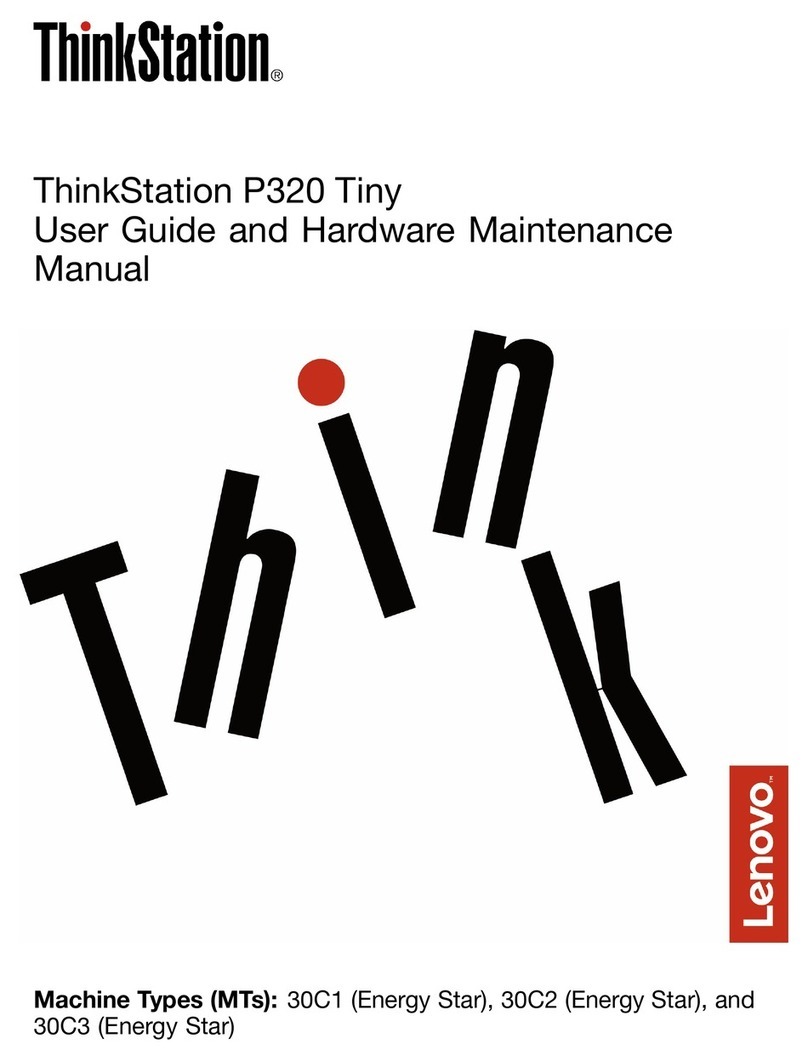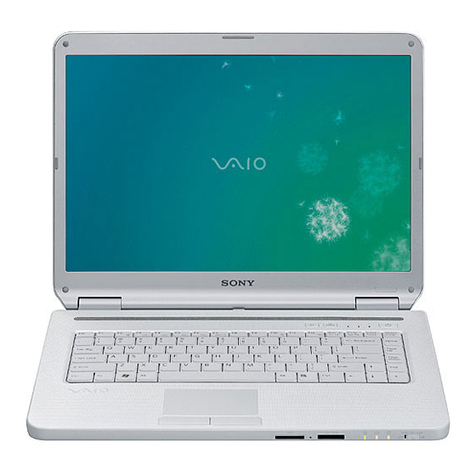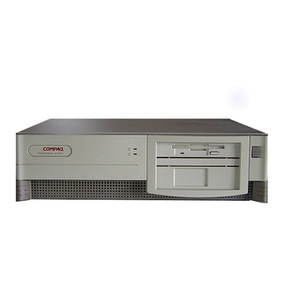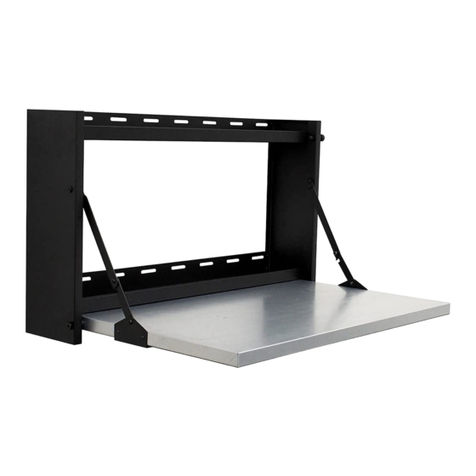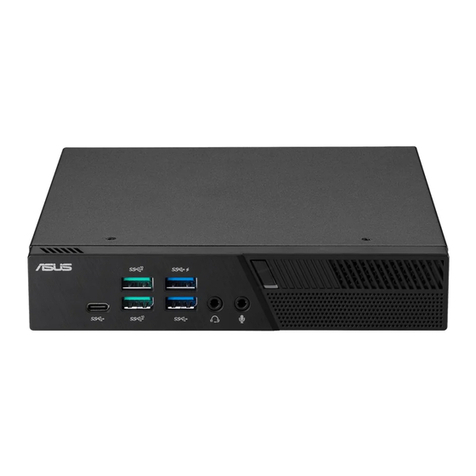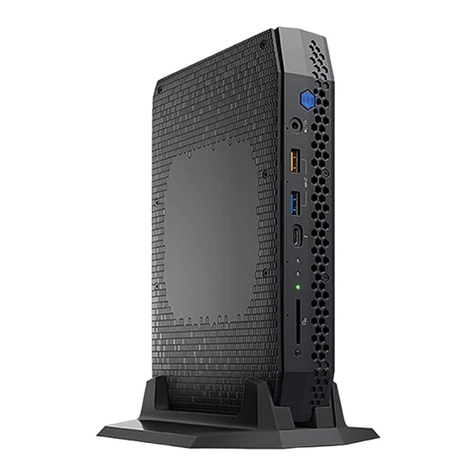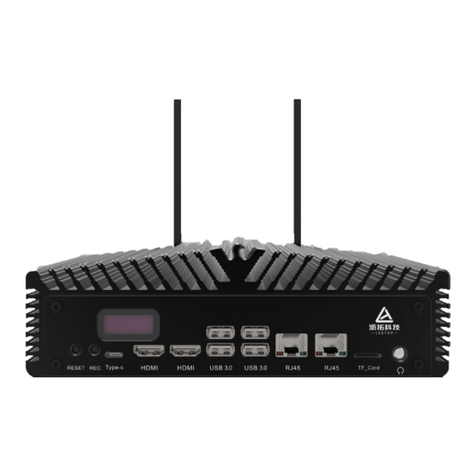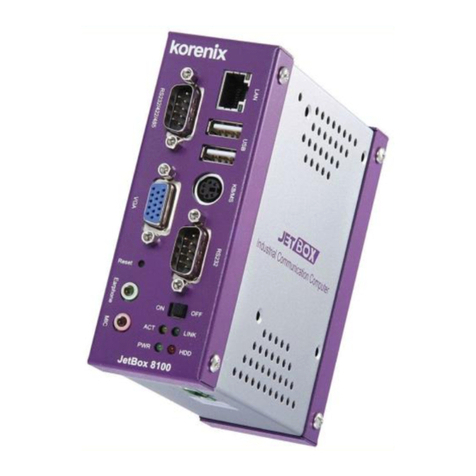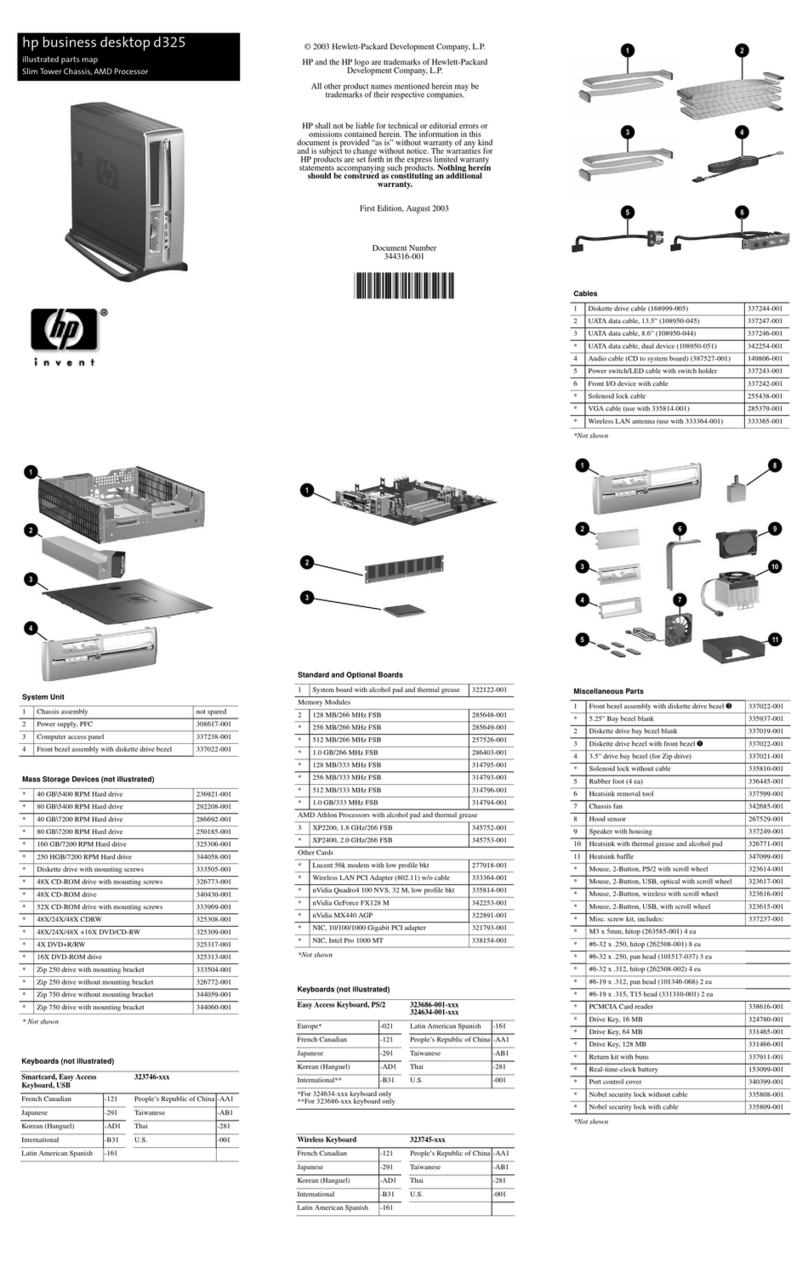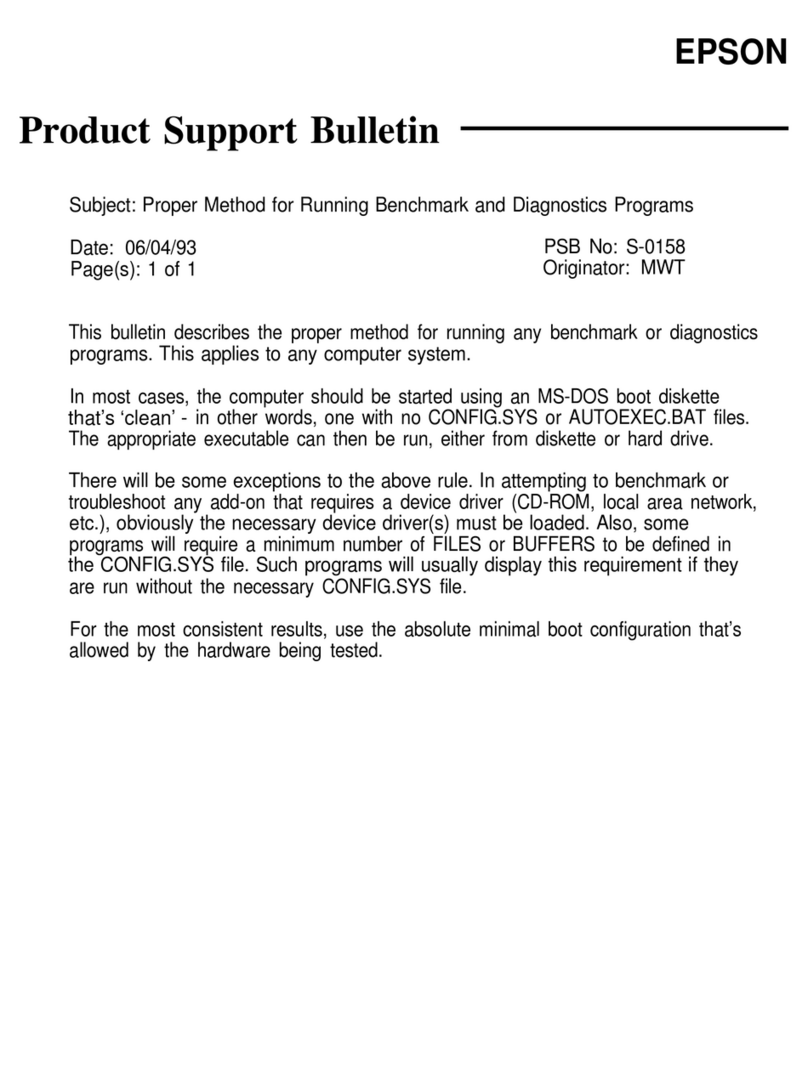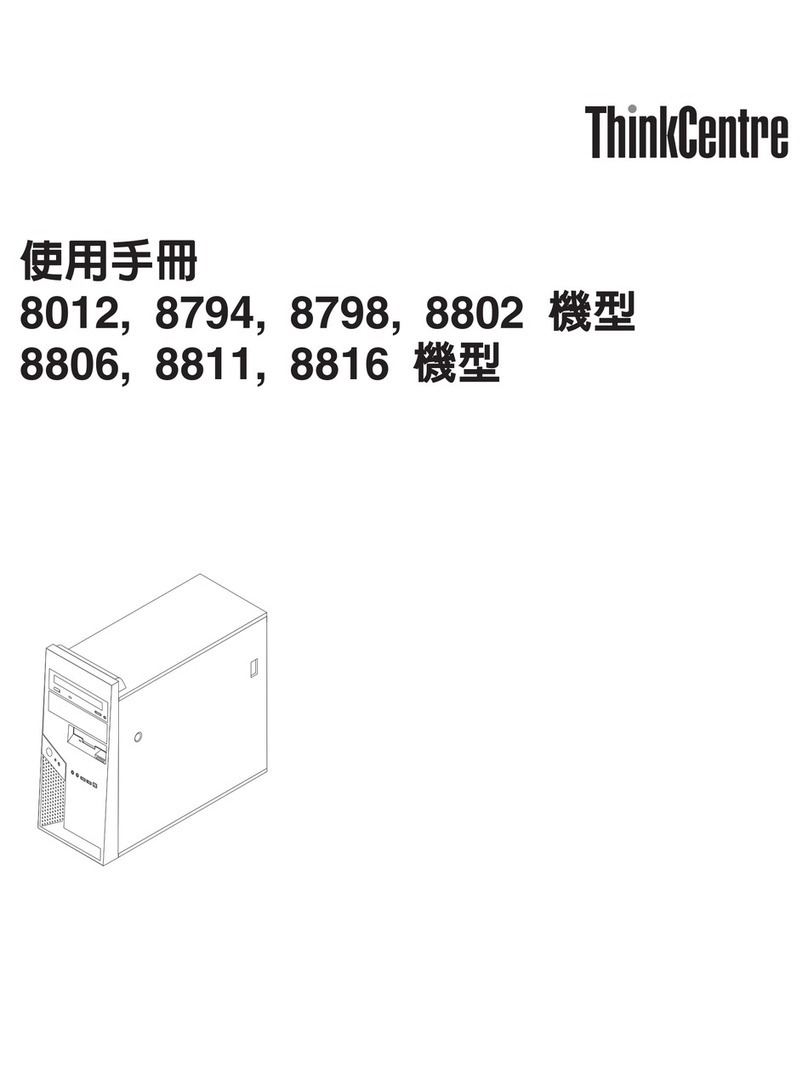ACT apricot User manual

apricot
Service
Manual

apricot
Service
Manual


I~
PREFACE
This
service
manual
contains all
the
information
required for the after-sales service
that
is required to
maintain
the
high quality and reliability of the ACT
APRICOT executive micro-computer.
It
is assumed throughout this
manual
that
all service
personnel involved
in
the
maintenance of the ACT
APRICOT already have an in-depth knowledge of digital
electronics,
with
particular emphasis
on
micro-computer
techniques.
This
manual
contains information relevant to
the
total APRICOT range. Illustrations and photographs used
are of
the
twin
floppy drive version. Please refer to relevant
sections for variations.
ACT (International) Ltd. wishes to acknowledge the
co-operation of
the
following companies for giving their
permission
in
allowing
the
reproduction of their proprietry
information:
SONY
(UK)
LTD.
National Panasonic
(UK)
Ltd.
Texas Instruments Ltd.
QED (Product Design) Ltd.
The
information
in
this
manual
is subject to change
without
notice and does
not
represent a
commitment
on
the
part of
ACT.
The
software description
in
this
manual
is
furnished under a license agreement.
The
software may be
used or copied only in accordance
with
the
terms of
the
agreement.
It
is against
the
law to copy any disk supplied
for any purpose other
than
the
purchaser's personal use.
© Applied ComputerTechniques PLC 1983.

I CONTENTS
Chapter
1 General description
2
3
4
5
6
7
8
9
10
11
Specification
Installation
Safety precautions
Recommended tools and
equipment
Assembly and disassembly
Electrical system
Electronic system
Memory
map
Set-up procedures
Trouble-shooting
Diagnosticprograms
Expansion Boards
Winchester
Appendix
A Monitor
B
Disk
drive
C Parts list
D PSU
E Circuitdiagrams, wiring diagrams
Index

r>
INDEX
Assembly and Features
1.2
Disassembly
5.1
Fuses 3.2
AC Sub Assembly
6.3
Floppy
Disk
Controller
7.13
Async Cable Installation
2.1
Connection
6.19
Interconnection
Block Diagram Apricot 7.22 Diagram 6.2
Conversion 240V
-115V
6.4
I/O
Section
7.11
Connectors Pin-Outs 6.6
I/O
Port Address 7.20
Circuit Diagrams
E1
I/C
Catalogue 7.23
Disassembly Modem Cable
Rear Panel 5.3 Connection
6.19
AC Sub Assembly 5.4 Memory 7.6
Motherboard 5.5 MemoryMap 7.38
Chassis Bridge Monitor
A.1
Assembly 5.6
Mnemonics
7.34
Disk
Drives 5.7 Parts Description
1.5
Front Bezel and
Door
5.8
Main Chassis 5.9 Printer Cable
Power Supply 5.9 Parallel 6.20
Handle 5.9 Serial
6.21
Speaker 5.9 Processor Structure
7.7
Monitor 5.10 Parallel Interface
7.14
Keyboard
5.11
Parts List
C.1
5.12 Power Supply
E.1
5.13 Recommended Tools
4.1
Diagnostic Recommended
Boot Prom Equipment
4.1
Documentation
Error Codes
9.1
Specification
1.4
Programs 9.5 Safety Precautions
3.1
Disk
Drive
B.1
System
Outline
7.3
Electrical System
6.1
Sound Generator
7.11
Serial Interface
7.18
Earthing
6.5
Set-Up Procedure
8.1
Expansion Information 6.16
Electronic System
7.1
Timer
7.16

&.....-1·
__..G_E_N_E_RA_L_D_E_SC_RIPT
__
I_O_N_---..II
[2J
I Features
II
,Specifications
III
Individual
units

GENERAL DESCRIPTION
rn
I FEATURES
Processor architecture
8086 running
at
5mHz
8089
I/O
processor
8087 Optional
Maths
co-processor
Memory
256 Kbytes expandable to 768 Kbytes
Mass storage
One
or two 3.5" Sony mirco-floppy disk
drives-
315
Kbytes each
or
One
or two 3.5" Sony double sided micro-floppy disk
drives-360
Kbytes each side
Display
I/O
9"
green P39 phosphor
with
antiglare filter
80 characters x
25
lines
Resolution: 800 x 400 pixels
1 x RS232
(V-24)
serial port
1 x 8-bit Centronics parallel printer port
Optional on-board
modem
with
auto-dial
2 x expansion slots
1 x "Mouse"
port
Keyboard
Soft QWERTY keyboard
with
8 fixed function keys
and 6
touch
sensitive keys labelled by LCD Micro-
Screen (tm).
Built-in 4 function calculator.
Time/Date
display
with
battery back-up.
Safety/radiation standards
Meets UL
VDE
BS415
CSA
FCC-B

11';;l1f'1
GENERAL DESCRIPTION
II
SPECIFICATION
Physical dimensions
Systems box: 16.5" (43.5cm) wide x
4"
(10.6cm) nigh
x 12.5" (33cm) deep
Monitor: 10.5" (27.7cm) wide x
B.5"
(22.5cm)
high x
10"
(26.4cm) deep
Keyboard:
16"
(42cm) wide x
2"
(5.3cm) high x
7"
(lB.5cm) deep
Weight
Systems box: 14.21bs
(6.5
kg)
Monitor: 9.11bs
(4.1
kg)
Keyboard: 3.31bs
(1.5
kg)
Power requirements
200 to 240
VAC
47 to
63
Hz
or
100 to
125
VAC
47 to
63
Hz
Power consumption
100Wat
115V
or 230V
input
Temperature range
Operating: 5 to
37°C
Storage:
-20
to 60°C
Humidity
Operating: 20 to
BO%
RH @
29°C
non-condensing

G£NEFALD£SCroVf\ON
ill
III
INDIVIDUAL
UNrf
S
1
1. Monitor
2.
SystemUnit
3.
Keyboard
4.
Microscreen tm
5.
Touch Sensitive
Keys
S
6.
FixedFunction
Keys
7. Door
8.
Brightness
control
2
~~II~I.illll~~~'{I9'
Video Cable
" 10. KeyboardCable
11.
Keyboard connector
12.
Centronics connector
13.
Serial connector
14.
Video connector
15.
Mouse port
16.
Mains
Switch
17.
Fuse
18.
Mains Input
16
18
17

1:11
GENERAL
DESCRIPTION
SYSTEMS
UNIT
External
1.
Systems Base
2.
Systems Cover
3.
Rear Panel
4.
Facia Bezel
5.
Door
6.
Expansion Plates
7.
Handle
8.
Base Clip
9.
Base
Button
2 10. Keyboard Cable Clips

Gf.Nf.~L
Df.SC\U¥flON
ill
NtONl'tO
lt
Bx
ter1l
:li
1
1.
Monitor
Bezc\
2.
Monitor
Base
3,
Moni.tor
CO'J
cr
4.
Peuesta\

I;,:;!)!
GENERAL DESCRIPTION
KEYBOARD External
1.
Keyboard Bezel
2.
Keyboard
Base
3. Battery Cover
4.
Contrast Wheel
5.
Reset Button
6.
Reset Plate
5
4~~
6

GENERAL
DESCRIPTION
rn
SYSTEMS
UNIT
Internal
1.
Disk
Drive
2.
Power
Supply
3.
Motherboard
4.
AC
Sub-Assembly
5.
Main
Chassis
6. Chassis Bridge
7. Expansion Slots
8.
Loudspeaker

Fil
L18
GENERAL
DESCRIPTION
MONITOR
UNIT
Internal
1.
Wire Frame
Monitor
2.
Top Screen
3.
Bottom Screen
4.
LH
Monitor
Bracket
5.
RH
Monitor Bracket
6.
Video Cable
7.
Brightness
Control
8.
Sunflex Screen
8

GENERAL
DESCRIPTION
rn
KEYBOARD
UNIT Internal .
1.
Keyboard Assembly
2.
Keyboard Cable
3.
Battery Connector
4.
Battery
5.
Reset Switch
6.
Brightness Control
7.
LCD Microscreen

I
__
IN_ST_~_L_L_AT_I_O_N
________
I~

INSTALLATION
rn
Each
computer
is carefully adjusted
and
strictly
inspected before
it
leaves
the
factory.
Correct
installation
is extremely
important
to
maintain
the
high
degree of reliability
and
performance
in-built
in
the
machine.
Note
the
following
recommendations:
1.
Ensure
the
line
voltage is
within
the
voltage
marked
on
the
outside
of
the
systems
unit.
2.
To
maintain
data
integrity,
the
computer
should
be
operated
in
an
electrical
environment
not
subject to
large voltage
transients
on
the
line. A
normal
office
supply is perfectly adequate. Avoid close
proximity
with
heavy
industrial
machinery
such
as presses, arc
welders, etc.
3. Ensure
the
operating
temperature
is
not
exceeded,
and
that
the
temperature
of
the
machine
is allowed
to
stabilise (for approximately 30 mins.) if
it
is moved
from
one
extreme
to
another.
4.
Do
not
obstruct
any of
the
ventilation
grills.
5.
Under
no
circumstances
must
any liquid
be
allowed
to
enter
any of
the
units.
6.
Operating
the
machine
in
an
abnormally
dusty
atmosphere
will
substantially reduce
the
life of
the
disk
drive
and
the
media.
7.
The
plastic case
of
the
machine
can
be
cleaned
with
a
damp
cloth.
Under
no
circumstances
use
an
abrasive
cleanser
or
solvent.
8.
Although
the
Sony
micro
floppy disks are
extremely
robust, a few
precautions
will
ensure
a long
and
trouble-free life:
(i)
Keep
auto
shutter
closed
at
all times.
(ii)
Never
touch
the
oxide surface.
(iii)
Do
not
exceed
their
temperature
range
(IO°C
to
60°C).
(iv)
Do
not
expose
the
disks
to
any
magnetic
field.
(v)
Do
not
attempt
to clean
the
disk
surface.
This
may
result
in
damage
to
the
disk
drive heads.

1o.o..ooo.·••••
··_.····.·S_A_F_ET_Y_P_RE_C_A_U_T_IO_N_S
__
---aI~
I General Safety Precautions
II
Fuses
ill
Power Supply

SAFETY PRECAUTIONS W
I GENERAL SAFETY PRECAUTIONS
1.
The
ACT Apricot has been designed to
meet
all
international safety standards
in~luding
UL,
VDE,
BS41S,
CSA
and
FCC-.B
radiation standards.
2.
It is recommended
that
installation of any expansion
boards or modifications, be carried
out
by
an
authorised
dealer-the
end user shouldnot dismantle
the units.
3.
Replacement parts should be of
the
type and rating
specified by
the
manufacturer, to prevent
the
risk of
shock or
fire.
Refer to appendix A
for
important safety
precautions
on
the
monitor.
4.
All earth connections should be maintained to
the
original specification, refer to Chapter
6.
Other manuals for apricot
2
Table of contents
Other ACT Desktop manuals

